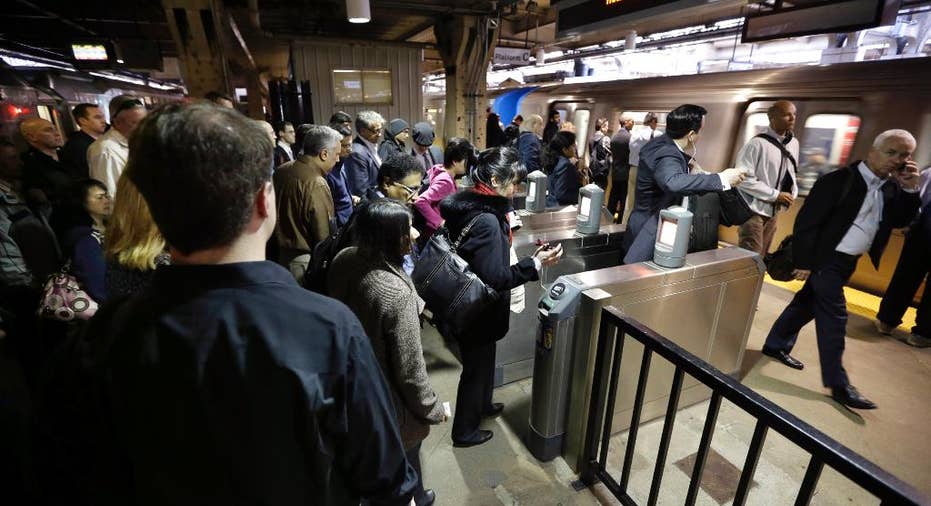Despite looming crisis, New York's Cuomo reluctant to dig deep for Hudson River rail tunnel

ALBANY, N.Y. – He committed billions of dollars to overhaul LaGuardia Airport and build a new Tappan Zee Bridge — but New York Gov. Andrew Cuomo has taken a wary approach to building a new Hudson River rail tunnel, even though the stakes could be even higher for the state and the nation.
The existing Amtrak tunnel connecting New York City and New Jersey is a century old and in disrepair. Electrical wires corroded by Superstorm Sandy's floods prompted hours-long delays last month that highlighted the tunnel's condition and previewed what could become a chronic problem if nothing is done.
Yet Cuomo sees little light ahead in this tunnel project.
The Democrat balked at an invitation from U.S. Transportation Secretary Anthony Foxx to meet with him and New Jersey Gov. Chris Christie to discuss the construction of a new tunnel, saying there was "no reason to meet now." He told reporters recently that the outlook for the tunnel is "not especially bright."
If that's true, then it's bad news for millions of commuters, not just the 200,000 people who ride trains through the tunnel each day. Amtrak estimates that the existing tunnel — which has a single track in two tubes, one for either direction — has a life expectancy of about 20 years. Closing one tube for a year of repairs would reduce the number of trains using the tunnel from 24 to 6 per hour at peak times, forcing tens of thousands of people onto ferries, buses or cars and further clogging the region's already congested streets.
Longer term, failing to build a new tunnel could strangle the Northeast Corridor between Boston and Washington right at its most critical chokepoint, drive down home prices in New Jersey and cut tax revenues for New York City, according to Richard Barone, director of transportation programs at the Regional Plan Association. A new tunnel, part of a $14 billion plan to improve or replace outdated infrastructure in New Jersey and New York, would likely take a decade to build.
"We're likely to see the region's economy take a serious hit," he told The Associated Press on Wednesday. "We'll be scrambling to adapt to an untenable situation where there aren't any good options. It would be a terrible outcome — for New Jersey, for New York and — I don't think this can be overstated — a problem for the nation."
Nonetheless, there are several reasons why Cuomo is reluctant to start up the tunnel boring machine. He said the project won't work unless Washington commits a sizeable investment. An earlier tunnel proposal included $3 billion in federal funds but was axed by Christie in 2010. Now Cuomo said the federal government is only promising loans.
"If the federal government is serious that this is critical, which it is — this is the entire northeast Amtrak route — we need federal funds," Cuomo said last week. "They need to put their money where their mouth is."
Christie has said he would support a new tunnel project if part of the cost was borne by the state of New York or New York City, neither of which pledged funds for the previous one.
Cuomo's tunnel stance is a departure for a governor who has seemed to revel in taking on big infrastructure projects. He used federal loans to finance the $3.9 billion Tappan Zee Bridge. Last month he joined Vice President Joe Biden to announce a $4 billion plan to rebuild LaGuardia's cramped terminals.
There are several key differences between those projects and the tunnel, Cuomo notes. Private airlines will cover roughly half of the cost of the new LaGuardia. And while the Tappan Zee is a state bridge, the new tunnel would be owned by Amtrak and used for New Jersey trains.
"It's not my tunnel. Why don't you pay for it?" he told reporters this past week.
The primary obstacle remains a financial one, and New York's would-be partners on the tunnel project don't inspire great confidence. New Jersey Transit has been plagued by budget gaps. Amtrak funding has been cut by Congress.
Sen. Charles Schumer proposed this week the creation of a new collaborative effort by New York, New Jersey, the Port Authority and the federal government to secure financing for the project. He also vowed to seek federal dollars.
"It will take energy, commitment, several leaps-of-faith, but above all else: it will take cooperation," he said of the project.
Port Authority chairman John Degnan has said the agency is willing to invest in the project, but that could be complicated by its having to redo its 10-year capital plan to include funding for a new bus terminal in New York City, expected to cost several billion dollars.
A spokeswoman for the U.S. Department of Transportation said the agency will work to secure help from Congress too — as long as the states get on board with the project.
"We know this project will be hard to get done," said Suzanne Emmerling. "We also know the alternative is much worse."



















